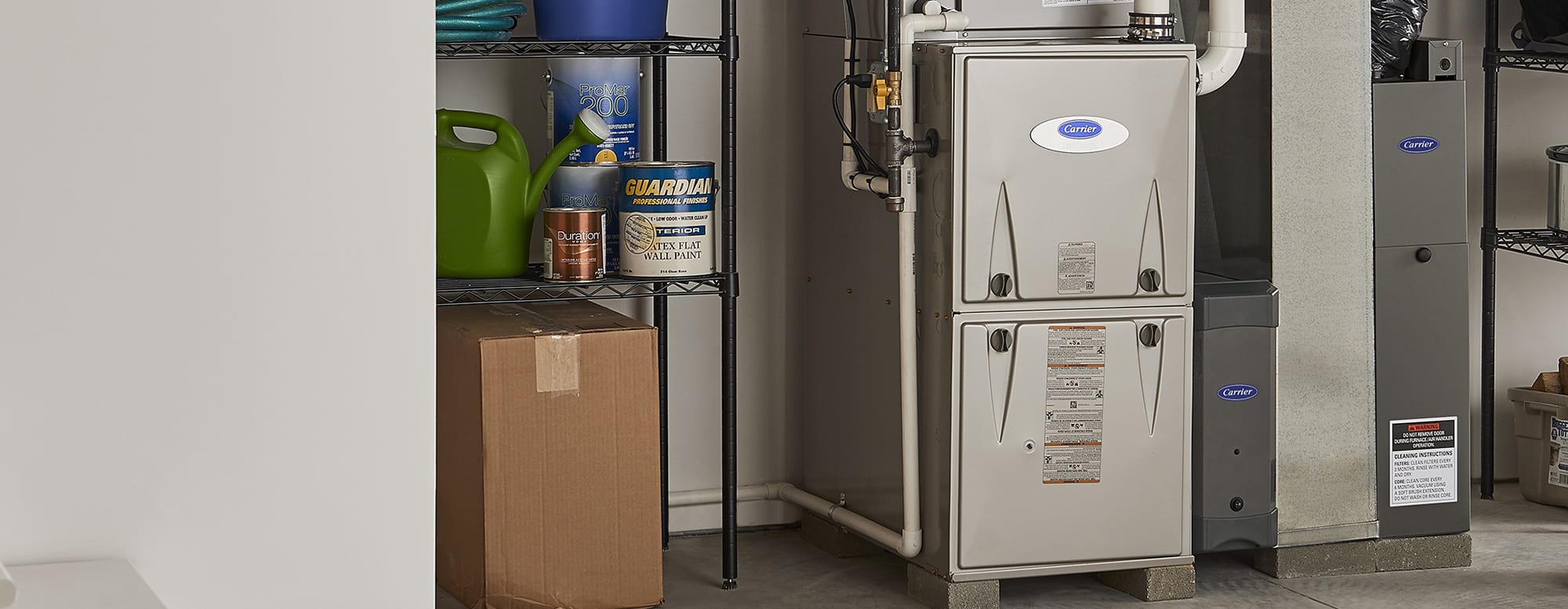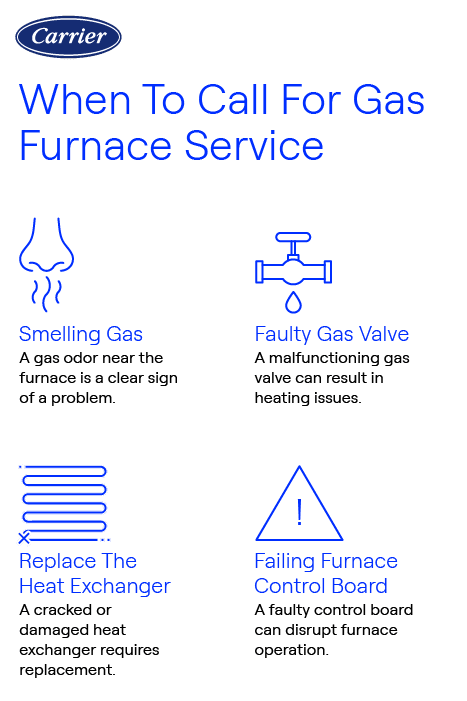Furnace Not Heating? Try Gas Furnace Repair
Gas furnace repair... three words no homeowner wants to think about. But the truth is, even the best Carrier gas furnaces don’t last forever. The longer you stay in your home – and the older your heating system gets – the likelihood that you'll be paying for a gas furnace replacement or repair will increase.
Common furnace problems you may experience – like inconsistent room temperature, higher than normal utility bills, reduced airflow and strange noises or smells – may signal it’s time to call a local Carrier dealer for gas furnace service.
But before you make the call, be sure to try some of the gas furnace troubleshooting tips described below. You may be able to resolve some issues yourself, or you might just confirm that the trouble is more suited for a qualified HVAC technician. Along the way, be sure to review our suggestions for extending the life of your furnace so you can delay the inevitable for as long as possible!

Troubleshooting for Common Gas Furnace Problems
Understanding how a gas furnaces works is a great first step if you plan to do your own gas furnace troubleshooting. At the very least it will help make your conversation with a service technician easier. Here are some things to try before you make the call:
Check the Thermostat and Breaker
If your system is running but you don’t have heat, check the thermostat to make sure it is set to heat. If the system isn’t on at all, check that the furnace switch on the side of the unit's cabinet is on, and be sure you haven’t tripped the circuit breaker.
Check the Furnace Filter
A clogged or overly dirty filter can restrict airflow, cause an increase in energy bills, and can put a strain on your furnace's blower motor. Clean or replace the filter as recommended by the manufacturer to keep the system running at its best.
Check the Heat Registers
Make sure your heat registers (vents) are open and unrestricted. If possible, remove the vent covers and make sure the ductwork isn’t clogged. Consider having your ductwork cleaned if you find excessively dusty, dirty buildup.
Check the Cabinet Access Panel
If you removed the access panel to check the filter or inspect the furnace, make sure to put it back in place. As a built-in safety precaution, the furnace will not run otherwise.
Check Intake/Exhaust vents
If accessible, go outside and check your system’s air intake and exhaust vents. Newer models are likely to have PVC vents, older units are likely to have metal exhaust vents. Be sure they aren’t clogged or blocked – a blocked vent can cause carbon monoxide build-up in the home.
Check the Pilot Light
If you have an older furnace, it may have a standing pilot light. If the pilot light is out, the burners will not ignite, and your furnace will not provide heat. Follow the manufacturer’s instructions on how to re-light the pilot.
Of course, your furnace may just be nearing the end of its lifespan. If that’s the case, you might want to start thinking in terms of gas furnace replacement and gas furnace cost .

When to Call for Gas Furnace Service

Furnace issues can be perplexing. Something as simple as soot build-up inside the furnace can signal the need for a major furnace repair. Other times, something that seems major – like the furnace turning on and off quickly, or not starting at all – can be resolved with just a relatively inexpensive service call from your local Carrier dealer .
Here are some situations that are best addressed by a gas furnace service performed by a qualified HVAC technician:
- Smelling gas – If you smell gas, it’s vitally important that you shut off the gas supply to the furnace, open doors and windows for ventilation, exit your home and have your system serviced. immediately. The cause could be a failed gas line, faulty gas valve or a cracked heat exchanger.
- Replace the heat exchanger – Signs of a cracked or failing heat exchanger can be soot build-up inside the cabinet, strong smells, or corrosion.
- Faulty gas valve – Signs of a faulty gas valve can be the furnace cycling on and off, no heat, or the CO detector sounding its alarm.
- Failing furnace control board – If your furnace takes several tries to start up, if the burners turn on and off frequently or won’t shut off completely, or if the circuit board itself is giving off a burning smell, the furnace control board may be going bad.

Gas Furnace Maintenance Tips
Just like regular tune-ups can keep a car operating at its best, routine gas furnace maintenance can extend the life of your heating system. Some preventative furnace maintenance tasks can be easily performed by most homeowners with only moderate expense.
- It is a good idea to clean / replace the furnace filter per the manufacturer’s recommendations. 1-inch filters should be replaced monthly, and 4-inch filters should be replaced once every three months.
- Keep the interior of the furnace cabinet clean – use a vacuum cleaner with a hose to carefully keep the interior surfaces dust-free.
- Schedule an annual inspection/cleaning with a qualified HVAC service specialist
Frequently Asked Questions
Here are some questions we hear on a regular basis regarding gas furnace repair:
According to several sources, some of the most frequent issues include dirty filter, ductwork, or replacing a flame sensor; fixing a faulty starting mechanism; broken blower components; and cracked heat exchanger or gas leak.
Your natural gas furnace might not be heating due to issues such as a malfunctioning thermostat, dirty or clogged filters, or ignition problems. Additionally, problems with the pilot light, gas supply, or a faulty heat exchanger could be the cause.
It is recommended to have your furnace serviced, cleaned and inspected annually.
A local Carrier expert can help with the following maintenance items:
- Clean or replace the air filter
- Test the thermostat for proper operation
- Check the heating output and return air temperatures with the furnace in heating mode
- Clean and check the burner, crossover, and igniter
- Check and adjust the gas valve
- Clean and tune the pilot light system on an older furnace
- Clean the heat exchanger and inspect for cracks, corrosion, or leaks
- Check and clean the blower assembly and motor
- Inspect wiring for damage to high temperatures
- Inspect the condition of the flue pipe and ductwork
- Leak-check the gas line and fuel supply components
A gas furnace from a reputable manufacturer should last up to 15 years or longer.
While there may be exceptions to the rule, you will likely experience the need for a gas furnace repair in your home. When that day comes, being prepared to troubleshoot the issue yourself just might solve the problem. But when the issue is beyond your level of expertise, knowing when to call a professional is important as well. And when that day comes, be sure to contact a trusted, professional Carrier dealer in your area.
- How Much Does it Cost to Replace vs Repair a Furnace?
- Learn about emergency HVAC repair
- Discover the signs you need a new furnace
- Learn what to do if your furnace is leaking water
- How long does a furnace last?
- Learn the causes of a furnace not kicking on

